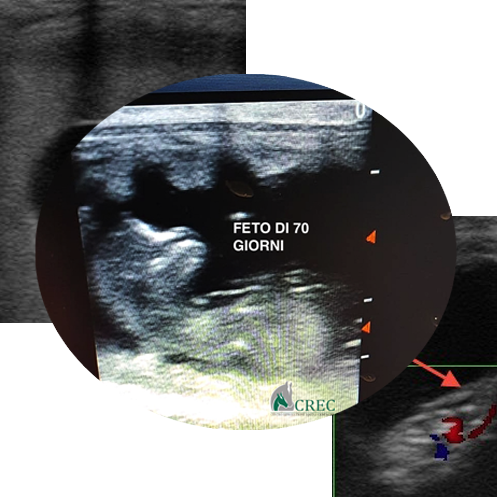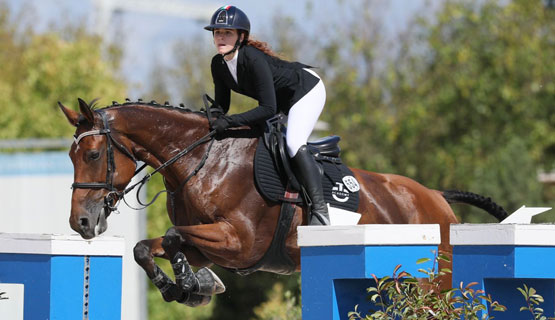Management of the mare during pregnancy
01.12.19
0 Comments

The purpose of this discussion is to provide simple points that can be useful to everyone, for proper management of the mare during pregnancy.
In literature, the average length of gestation of the mare is 335 days, with a range that
it can range from 320 days to 370 days, due to the fact that pregnancy can be influenced by various factors that can vary its duration:
- age of the mare,
- period of the year in which the presumed date of birth is placed,
- primiparous or multiparous horse (1st birth or which has already given birth other times in his life),
- diseases affecting the mare or pathologies affecting the gestation itself (eg placentitis),
- feeding / status of the mare,
- individual factors.
CONTROLS
A good management of the mare, includes a series of veterinary checks that allow to evaluate the correct course of the pregnancy and allow to identify possible alterations or pathological states that may require pharmacological treatments. The goal is to ensure, during pregnancy, the well-being of both the fetus and the mother.
The first check, that is the diagnosis of pregnancy, is carried out at 14 days from the ovulation of the mare. This is the moment when the mare is pregnant.
Already at this stage, the veterinary surgeon, through ultrasound examination and palpation, can assess whether to start a therapy to support pregnancy by administering
Exogenous progesterone.
During the first check, the presence of a second vesicle is also excluded. In horses, twin pregnancy entails high risks for both the mare and the development of the fetus. It is good practice to reduce one of the two vesicles between the 14th and 15th day of pregnancy when
the embryo is mobile and has not yet nested in the uterine wall.
At 25-30 days of pregnancy, a second ultrasound check is performed to assess the presence of an embryo and its heart rate. In the event that an anembrionate vesicle is found, ie without the embryo, the pregnancy will not proceed in
how much the structures assigned to the formation of the fetus are missing.
Subsequent checks must be agreed with your veterinarian based on different needs and risk factors.
On farms, in conjunction with the administration of the anti-abortion vaccine (5th-7th-9th month of pregnancy) ultrasound checks are performed to monitor fetal viability / morphology and placental function. These allow the early identification of pathological changes that can be an index of placentitis in progress; the sooner they diagnose and the more successful the drug treatment will be.
The control at the 10th month instead, allows to investigate the position of the fetus near the birth. The fetus must have a cranial presentation (head towards the mother's pelvis and posterior towards the mother's head); with the ultrasound we can be accountable for a possible
wrongly, for example if a caudal position were to be found, one would have to take in
consideration of an assisted birth in the clinic and a possible caesarean.
It should however be specified that the control at the 10th month cannot be diagnostic for all the dystocias that may occur during childbirth.
The flu / tetanus vaccination is also carried out during the visit; this guarantees the unborn child a share of maternal antibodies in the milk sufficient to cope with any infections during the first months of life.
During this visit the veterinarian removes the vulvoplasty (Caslick), in case it was
previously performed on the mare.
Beyond all the routine checks that can be carried out, it is important for the owner to always keep the mare under control.7
In a pregnant mare it will be necessary to check with particular attention the absence of anomalous vulvar drains and an enlargement
early breast, all symptoms due to an ongoing pathological state.
In these cases it is advisable to call a veterinary surgeon IMMEDIATELY as the pregnancy could be seriously at risk.
SUPPLY
Within a good management of the mare there is certainly an accurate control of the feeding. In the first months of pregnancy the mare does not need different nutritional supplies compared to a horse at rest, it is simply necessary to guarantee a good hay and a good maintenance feed.
The mare must not be excessively thin otherwise she will not be able to support a correct fetal growth. Even an excessive increase in the weight of the mare can be a risk factor for pregnancy due to the impairment of the placental vasculature and to the difficulties in which the mare may incur during the expulsive phase of the birth.
Hay is a very important component of the ration, ensuring that it is of good quality and does not contain mold, as these can be one of the causes of abortion.
Energy intake will instead be increased during the last trimester of pregnancy and during lactation. In fact, the last quarter is the period in which there is greater fetal growth and in which the dam will have to give more to the future unborn child; in that period it will therefore be
It is appropriate to integrate a good protein core with the maintenance ration and continue the administration even during lactation.
TREATMENTS
As already mentioned in the first paragraph, it is advisable to carry out some vaccinations during pregnancy. It is always good to seek advice from your veterinarian who will establish a vaccination plan.
At the 5th, 7th, 9th month of pregnancy, the three anti-abortion vaccinations EHV 1,4 (Herpes virus) are carried out, this is one of the most frequently involved viruses in the late abortion of the mare (generally from the 7th month onwards ). It is advised to vaccinate against Herpes virus since it is now
endemic in our area and in most of the world, and is present mainly in
farms with a large number of horses. Being a latent virus you have a high one
probability of coming into contact with animals that are perhaps only carriers but not symptomatic and possible transmission may occur in different ways: through nasal discharge, direct contact, contact with placental fluids or with the products of an abortion. Vaccination allows
therefore to reduce the risks linked to exposure with this virus.
The other important and recommended vaccination, as we have already mentioned, is the flu / tetanus of the tenth month of pregnancy.
The other routine treatments to be done are wormers; most wormers are now safe both in pregnancy and in lactation but it is always advisable to consult the doctor
Veterinarian before administration.
Consult your veterinarian even before the administration of any other drug as some may be potentially harmful to the fetus.
STRESS
Other factors that are often not taken into consideration but that are of great importance are the different causes of stress that can affect gestation.
In fact, any stress factor, by inducing a decrease in immune defenses, exposes the mare to a higher number of risks.
The most common reasons for stress are: long journeys, incorrect nutrition and changes in the pack. It is advisable to form groups of mares that will give birth more or less in the same period and minimize travel between herds.
It should also be avoided to put new horses in contact with the mares already present in the place to reduce the transmission of diseases that may also be latent and not obvious on arrival; in this case you should have an area reserved for quarantine in
so as to keep the horses in isolation just entering the structure. During gestation it is necessary to take particular care of the general condition of the mare; the onset of any pathology can however be a stress factor and put on
risk pregnancy itself. In conclusion, it is impossible to control all the situations that may arise during
pregnancy, but a good management of the above mentioned factors allows to follow the mare in the best way and to avoid the onset of some problems that can be harmful both for the mare and the foal. Correct management therefore allows to increase the numbers
probability of success.

.png)

Leave your comment